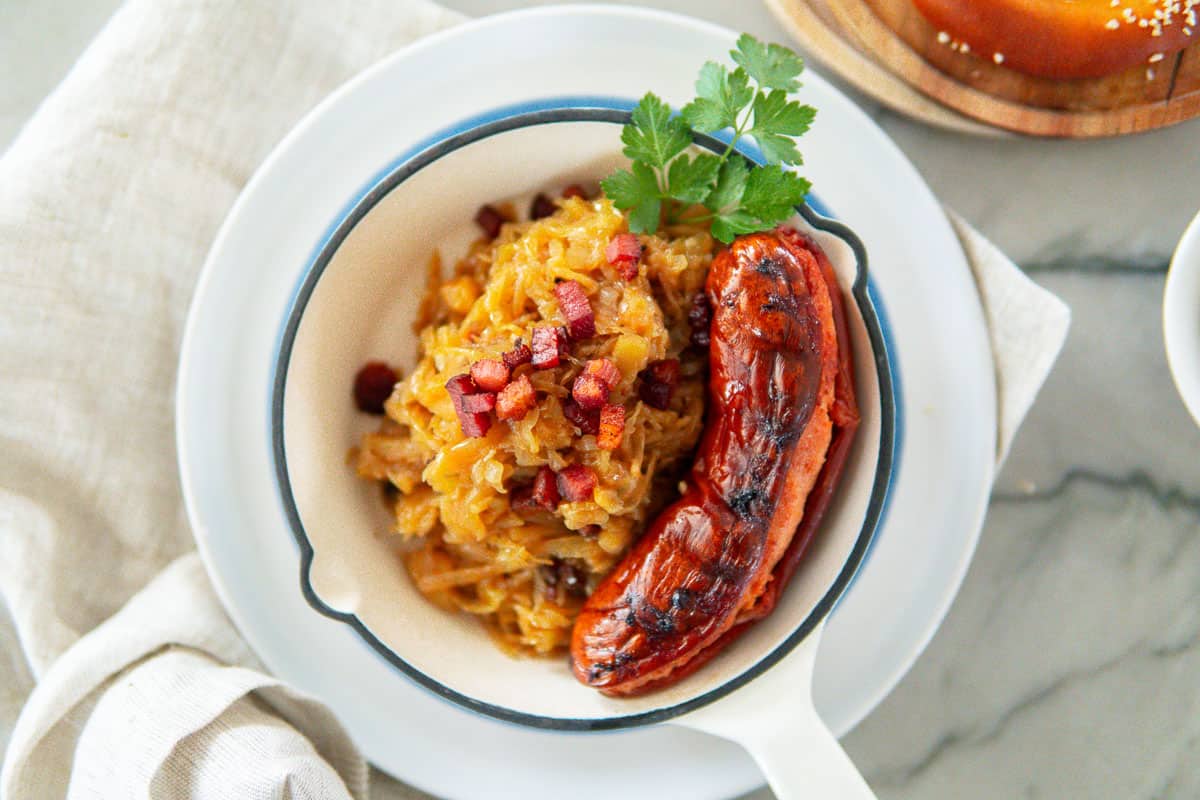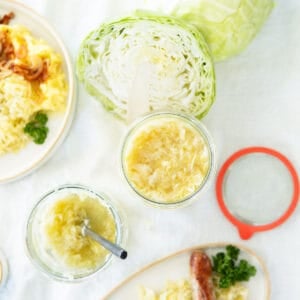Sauerkraut is a German food staple and NECESSITY. And I bet this super easy sauerkraut recipe with the perfect crunch, tang and salt level will convince you too. People may even call Germans Kraut (aka cabbage) and it's because most Germans do love their cabbage very much.

And you'd be surprised just how super easy it is to make healthy, delicious sauerkraut at home, using things and tools (like a knife and a jar) that you already own. The ingredient list is so short, that I am almost embarrassed to call it a recipe. Making sauerkraut is as simple as combining cabbage and salt. That's it!
So this sauerkraut recipe is another one of those German recipes, where it's not so much about fancy ingredients. Instead, it's about technique and understanding the process that magically turns cabbage into sauerkraut.
Using my authentic German sauerkraut recipe, you can make as little as one quart/liter jar of sauerkraut (aka one recipe) or as much as a bucket full. It's totally your call. But if you make only one jar of it, you will wish you had made more!
Is homemade sauerkraut better?
Yes, homemade sauerkraut is is better for a few reasons listed below.
1. Fresh sauerkraut is healthier
Jarred sauerkraut you can buy at the store has been heat-treated aka pasteurized to make it shelf-stable. This process destroys many if not all of the natural probiotics and gut-healthy bacteria that grow during the one-week-long fermentation process.

Fresh sauerkraut contains lots of vitamin C, K vitamins, lots of fiber and natural probiotics from the fermentation process. Eating fresh sauerkraut is a great immune booster and can even help you lose weight!
Only if you eat unpasteurized or raw sauerkraut, can you see a positive effect on your gut microbiome.
2. It's so easy to make!
You will not believe just how simple and easy it is to make sauerkraut at home. The ingredient list? There are TWO ingredients. Cabbage and salt. The tools list? You can dumb it down to simply using a good kitchen knife. PLUS you'll need your healthy hands for kneading and extracting the cabbage juices. This step is essential to start the fermentation.
3. A great way to use up cabbage and make it last
Find yourself with a bunch of cabbage, but don't want to turn it into a meal? (And if you do, you MUST try my cabbage rolls called Kohlrouladen in German.) Then making sauerkraut is an easy way to 'preserve' your cabbage for months to come. The fermentation process takes about a week after which I transfer it to the fridge. Sauerkraut will stay good in the fridge for about 3 months (or longer).

4. It's a fun way to experiment!
Now that I have gone down the homemade sauerkraut hole, I want to create many different variations of it!
- Next, I want to add roasted garlic into my sauerkraut jars.
- You could also add toasted caraway seeds, which help with digestion, too. A win-win.
- Adding other veggies such as thinly sliced peppers or carrots would also be delicious.
- And then there is a whole possibility of spices you could add to the mix. A spicy sauerkraut (with added Calabrian chili paste?), anyone? This is totally not authentic German, but I love spicy and know this would taste so good!
How does cabbage turn into sauerkraut?
Making sauerkraut at home is a bit like a fun science experiment. You start by thinly shredding your cabbage. As scary of a tool as it may be, but I love using a mandolin slicer for this part (and a protective glove). It makes it super fast and even. You could also just use a large kitchen knife and you will likely end up with larger pieces. But they will taste just as good.
Next, you will knead the shredded cabbage with some salt for about 10 minutes. At some point in the kneading process, you will wonder if you're doing the right thing. That's when you keep going and a minute later, you will see juices being extracted from your cabbage pieces. Continue kneading for the full 10 minutes, then pack the cabbage into sterilized jars. One recipe will fill about 1 quart/liter jar.

Press down the cabbage until the juices cover the top and seal the jar. I love using these pretty Weck jars and they come with a reusable rubber seal and brackets.
Now, you place them in a cool spot in your home (60 to 70 degrees Fahrenheit is optimal) and wait for about a week.
During that week, a process called lactic fermentation happens. The combination of the cabbage juices, the salt brine, and the cooler temperatures is the perfect breeding environment for these gut-healthy bacteria. They are responsible for making your sauerkraut taste tangy and sour ("Sauer" in German).
After the fermentation, simply move your sauerkraut to the fridge to slow fermentation and enjoy it for up to 3-ish months.

While you could also process your sauerkraut to make it shelf-stable, storing it in the fridge will keep the natural gut-healthy bacteria alive. This is why it's also healthiest to eat raw sauerkraut because heating or cooking it will destroy your natural probiotics as well.
Sauerkraut recipes
Eating raw sauerkraut is unusual for Germans, but I have embraced it, understanding the added health benefits.

A simple way to eat it raw is to serve it with mashed potatoes and some cooked Bratwurst. I love this authentic German-style Bratwurst from the NYC-based German butcher Schaller & Weber. Schaller & Weber's classic Bratwurst is award-winning and THE BEST I've had stateside. And I also LOVE their truffle Bratwurst with added black truffle. Adding another complexity layer into this fantastic, simple dish.

I top my mashed potatoes with some crisped pan-fried onions (toss them in a bit of flour before cooking) and it's just the PERFECT, rustic German meal.
If you prefer to eat your sauerkraut warm like most Germans do, I LOVE these German sauerkraut recipes:
- How to cook sauerkraut (this should convince any sauerkraut skeptic!)
- Schupfnudeln (the most delicious potato noodles!)
- Sauerkraut casserole (my aunt Heidrun's favorite meal)

I hope you found this sauerkraut recipe inspiring and I wish you much success in your fermenting journey!

How to Make Sauerkraut (German Recipe)
Equipment
- 1 quart-sized jar linking a set of my favorite German Weck jars here, so you can make lots of sauerkraut
- 1 Mandolin Slicer for even, thin cabbage slices and it's way quicker
- 1 protective glove to prevent cuts because I've definitely cut myself with a mandolin slicer before!
Ingredients
- 1 kg cabbage feel free to experiment and white/green cabbage or red cabbage
- 10 g sea salt
Instructions
- You'll need one liter/quart sized jar for each kilo/two pounds of cabbage. Clean out your jars with hot water and mild soap. Unless your jars are brand new, it's best to sterilize them by boiling them in hot water for 10 minutes. Remove from the water and let them cool down before using.
- Remove the outer leaves of the cabbage, cut in half and then each half into thirds. This way they will fit onto a mandolin slicer. Now thinly slice the cabbage. The thinner, the better. I use the second thinnest setting on the mandolin slicer. Combine in a bowl with the salt.
- Now it's time to roll up your sleeves and knead the cabbage for about 5 to 6 minutes. You may want to skip your arm workout that day. The kneading with the salt helps to extract all the natural juices in the cabbage and you should have quite a bit of juice in your bowl once you're done.
- Fill the cabbage into jars, pressing it down, so it's covered by the juices. Leave about an inch of room to the top of the glass. Tightly seal your jars with the lid.
- Place the jars on a rimmed tray and wrap in old linen towels. It's possible that some of the juice will bubble up during the fermentation process and find its way out of the jars. The towels will help soak up the juices. Allow to sit at room temperature for one week.
- Once there are no more bubbles, loosely seal your sauerkraut and store in a cool and dark place for up to a year. I just keep mine in the fridge because we don't have a cool cellar like so many Germans do. Your sauerkraut is ready to eat!It will however continue to ferment slowly and the taste will change over time as well.
- You can enjoy it raw, which will leave all the good probiotics and vitamins intact, or you can cook like I did in this sauerkraut recipe, for Schupfnudeln or my aunt's sauerkraut casserole.





Matt
Thanks.
Have been waiting for you to do this for ages
Cant wait to try. Matt
dirndlkitchen
PERFECT! Let me know when you get to try it out!